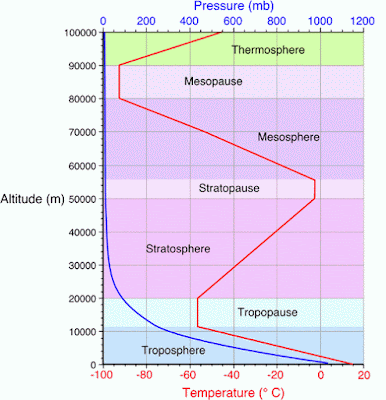Structure of the atmosphere
The atmosphere is made up of several gasses;
- 78% Nitrogen
- 21% Oxygen
- ~0.01% Water Vapour, Carbon Dioxide, Ozone, Methane, Argon, Helium etc
|
Troposphere
|
It contains all of the elements vital to life, plus most of the water vapour in the atmosphere, most of the clouds, dust and pollution. Most weather happens here. The temperature decreases rapidly with increasing distance from the Earth’s surface. This is largely because the Earth is heated from the surface outwards, as it receives incoming solar radiation as UV rays which is converted to heat at the surface. Pressure also decreases with height in this zone, and the amount of Oxygen available decreases. The top of this layer is marked by the TROPOPAUSE, where temperatures remain constant, (isothermal). |
|
Stratosphere
|
Temperatures increase with height as ozone absorbs the UV. The layer is free of dust and cloud and ozone not only absorbs but filters out UV. The upper layer is known as the STRATOPAUSE another isothermal layer. The Stratosphere does have winds, but these are light in the lower layers and increase in strength with height. |
|
Mesosphere
|
Temperature decreases to -90. No water vapour or dust to absorb radiation. Very strong winds at 3000 km/hr. Topped by another isothermal layer, the MESOPAUSE. |
|
Thermosphere
|
Temperatures increase to 1,500 C due to the absorption of UV radiation by atomic oxygen. |

No comments:
Post a Comment